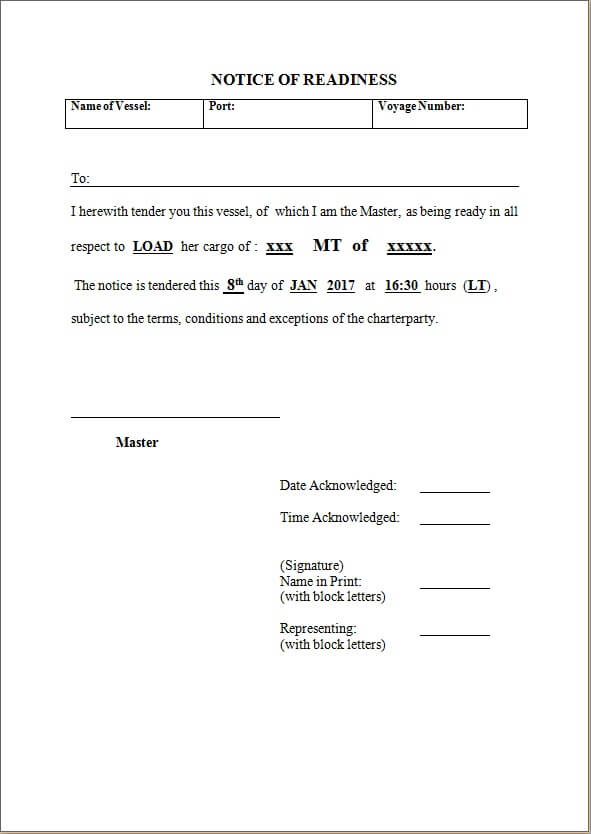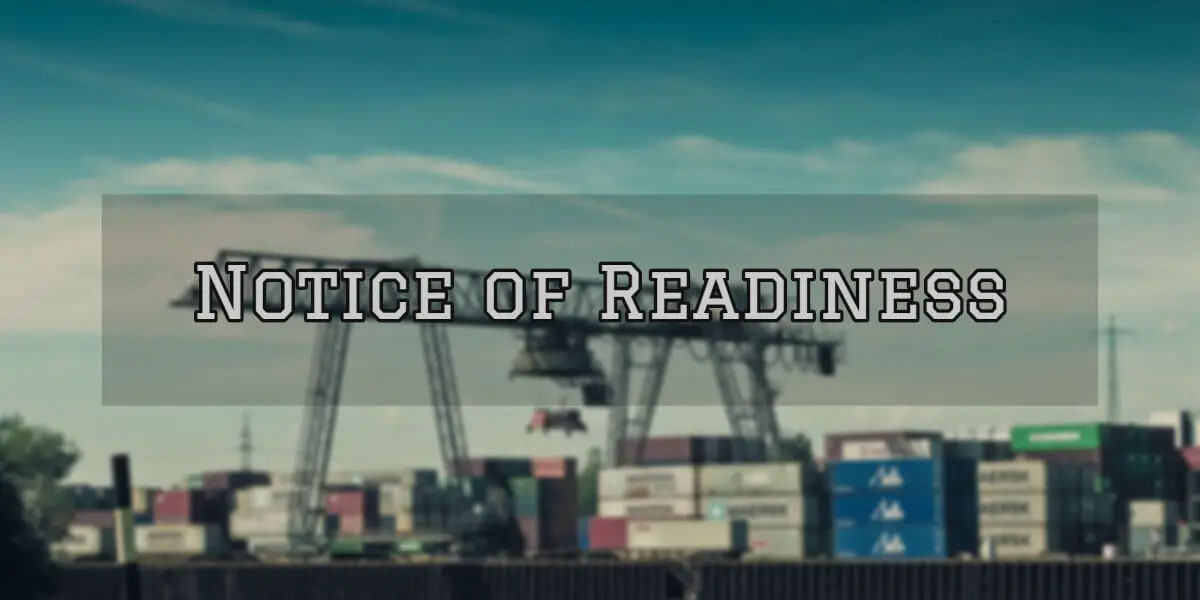Definition
The Notice of Readiness (NOR) is the document used by the Ship Master, to notify his ship readiness, in every respect, to load and/or unload the goods during the period of his charter. NOR is an extremely important document as it triggers the commencement of laytime. “Laytime” is the term used to refer to the time allowed to the charterers to load/discharge cargo in return for payment of freight to the owners.In a case of invalid NOR, the vessel might not be considered as arrived ship and therefore all waiting time until berthing will be refuted in the demurrage claim.
The Notice Of Readiness (NOR) is always to be tendered in accordance with the terms of the Governing Charter Party. Unless otherwise advised, the NOR should be tendered to all parties as per voyage orders, stating that vessel is in all respects ready to load or discharge her cargo. If the vessel becomes not ready, then NOR will be tendered when the vessel has corrected whatever was the cause of her not being ready to present NOR.
Contents of NOR
The notice of readiness is the notice to the charterer, shipper, receiver or another person as may be required under the charter-party that:
- The vessel has arrived at the specified destination where the notice of readiness can be given. It can be said briefly that the specified destination will depend on the terms of the contract. Various clauses in the charter party may advance the time that the vessel may tender the notice even though she may not be at the specified destination. The most familiar are the WIBON (“whether in berth or not”) provision which means that under a berth charter party, if the berth is not immediately accessible, the notice of readiness may be given when the vessel is in the port in which the berth is situated. Similarly a WIPON (“whether in port or not”) provision will enable the notice in certain circumstances to be tendered even if the vessel has not yet entered the port area.
- The vessel is ready to load or discharge the cargo as the case may be. This means that the vessel must be both physically ready in that the holds are ready to receive the cargo and legally ready in that all documentation necessary to enable her to commence loading is in order. If, however, the vessel is ready to subject only to a mere formality then the notice may still be able to be tendered. For example, if customs clearance is only obtainable on berthing but the notice can be tendered when the vessel is off berth then this will not affect the vessel’s readiness.
- All other requirements under the charter party concerning the form, timing and the party to whom the notice is to be tendered have been complied with.
Requirements for a valid notice of readiness to be served
- The vessel is an arrived vessel.
- The vessel is ready to receive or discharge the cargo.
- The notice of readiness is tendered to and received by the proper person according to the charter-party.
- The notice of readiness is tendered in a contractual way.
- The notice of readiness is tendered at a time that is allowed by the charter-party.

Sample Notice of Readiness NOR
![]()
The original NOR is to be confirmed by a NOR in writing, which is to be submitted to and signed by an authorised person when the vessel is all fast. The written NOR should clearly state that NOR was first sent by email, telex, … and should show the date and hour of the initially sent NOR. If you have been instructed to tender NOR prior commencement of laydays and your vessel is still awaiting berth upon commencement of laydays, it is advised to re-tender NOR upon commencement of laydays, adding the wording “without prejudice to first NOR tendered at ‘datelTime”. For multiple berth cargo operations, an NOR should be tendered for each berth using the time of hose disconnection from the previous berth as NOR tendering time for next berth. If the discharge is part STS transfer or lightering with balance alongside a berth, two NOR’s are to be tendered (one for lightering and one for berth discharge).
Case Study
Port charter party – “within port limits” defined.
The Facts
A fixture recap contained the following clause:
“15. Notice of readiness to be tendered at both ends even by cable/telefax on vessel’s arrival at load/discharging ports within port limits. The notice of readiness not to be tendered before the commencement of lay days.
- … Otherwise, Gencon 94 printed form charter party with logical amendments on the terms as per fixture recap.
Clause 6(c) of Gencon 94 included the following under the sub heading “commencement of laytime (loading and discharging)”.
If the loading/discharging berth is not available on the vessel’s arrival at/off the port of loading/discharging, the vessel shall be entitled to give notice of readiness within ordinary office hours on arrival there … laytime or time on demurrage shall then count as if she were in berth and in all respects ready for loading/discharging provided that the master warrants that she is, in fact, ready in all respects. Time used in moving from the place of waiting to loading/discharging berth shall not count as laytime”.
Due to congestion, the vessel anchored outside the port limits of Krishnapatnam as depicted on the relevant Admiralty Chart.
Despite this, owners tendered notice of readiness and claimed demurrage.
Findings
Messrs Williamson and Schofield found for the charterers.
Owners were given permission to appeal on the definition of “port limits”
Mr Justice Knowles CBE upheld the arbitrators’ award.
He held that where there is a national local law that defines the limits of the port in question, those are the limits that will apply in the case of that port. Where there is not such a law, then a good indication of what the port limits are is given by the area of exercise by the port authority of its powers to regulate the movements of the conduct of ships.
Here the arbitrators did the best they could with material offered to them: the Admiralty Chart.
Commentary
The outcome seems fairly obvious.
The value of “port limits” as a criterion for an arrived ship remains questionable.
All that should matter is the quality of the vessel’s position and the readiness of access to a berth when one becomes available. – as seen on Charter Party Cases

Very informative n useful.
Tks.
NOR can be only tendered when vessel in port limit or Drop anchor in port limit or pilot on board time.
NOR can never be applicable for the vessels EOSP.
Hi, “NOR can never be applicable for the vessels EOSP” Why please?
IF a COTP is issued, does time stop for all parties until the COTP is cleared
what means that nor to b tender wwww – found it in contract between shipper and cnee
4 “W’S” refer to:
1) WIBON- whether in berth or not
2) WIPON- whether in port or not
3) WICCON- whether in customs clearance or not
4) WIFPON- whether in free pratiqie or not
4 “W’S” refer to:
1) WIBON- whether in berth or not
2) WIPON- whether in port or not
3) WICCON- whether in customs clearance or not
4) WIFPON- whether in free pratiqie or not
What it means if NOR is served??
Is it only tendered or both ( tendered and accepted)
May a terminal representive, sign with a “for receipt only” stamp on a NOR?
when there is a rule on the NOR: “accepted/received”
The acceptance time for NOR by a terminal is only when everything is in order such as loading nomination for both vessel and terminal is aligned, ship/shore safety checklist is in order, tank;s is inspected and fit for loading
Is this correct or otherwise please advise.
If an owner furnished a Q88 for an altered Load line, which which had not been re-measured and certified by a class surveyor, can the NOR be valid.
Great post! The explanation of the Notice of Readiness (NOR) and its requirements was very clear and informative. I particularly appreciated the breakdown of the contents, as it made it easier to understand its purpose in the shipping process. Looking forward to more insights on maritime documentation!
This post does a great job of breaking down the Notice of Readiness (NOR) concept! I appreciate the detailed explanation of its contents and requirements, as it really clarifies the process for those of us who are new to shipping logistics. Thanks for the insights!
This post on Notice of Readiness is incredibly informative! I appreciate the clear breakdown of its definition and the detailed outline of the contents and requirements. It’s helpful to understand the implications in shipping contracts. Thank you for such a comprehensive guide!
Great breakdown of NOR! I appreciate how you clarified its importance in the shipping process and outlined the essential contents and requirements. It really helps to understand the implications for both shippers and receivers. Looking forward to more insightful posts like this!
This blog post on Notice of Readiness is really informative! I appreciate the clear breakdown of the definition, contents, and requirements. It’s helpful to understand how critical this document is in the shipping industry. Looking forward to more insights like these!
This post provides a clear and thorough explanation of Notice of Readiness (NOR). I appreciate the breakdown of its definition and the detailed list of contents and requirements. It really helps demystify the process for those of us who are new to shipping and logistics. Thanks for the valuable insight!
This post on Notice of Readiness is incredibly informative! I appreciate the clear breakdown of its definition and the essential contents required. It’s helpful for anyone involved in shipping or logistics to have such detailed insights. Thank you for sharing this valuable information!
Great post! I found the explanations on the Notice of Readiness and its requirements very insightful. It’s crucial for us to understand this process in the shipping industry. Thank you for breaking it down so clearly!
Great insights on the Notice of Readiness! I appreciate the detailed breakdown of its definition, contents, and requirements. It’s really helpful for those of us navigating the complexities of shipping and maritime operations. Looking forward to more posts like this!
That’s exactly how things should be defined. It’s such a pain sometimes to find a good explanation and it’s great when you manage to find a decent article that explains things properly. Ton of time saved and you really have the understanding